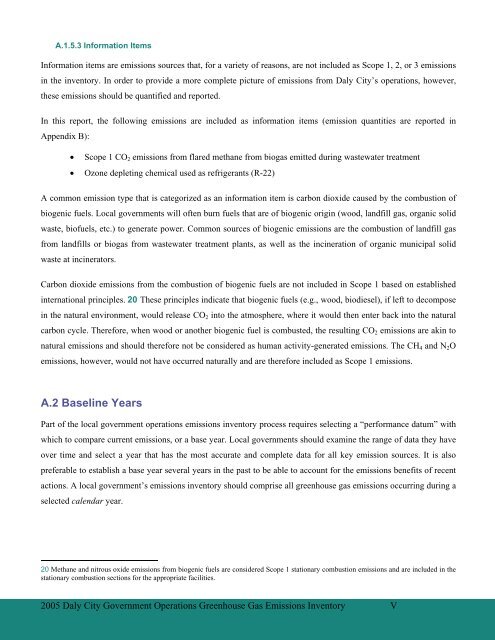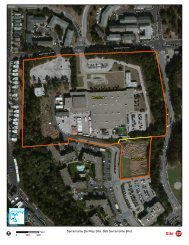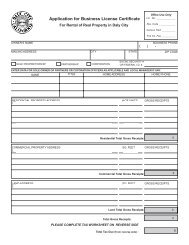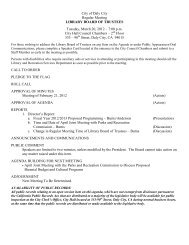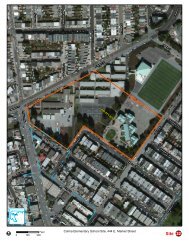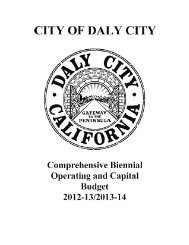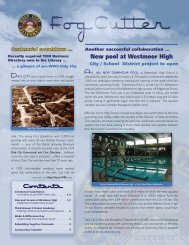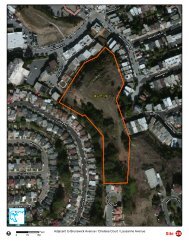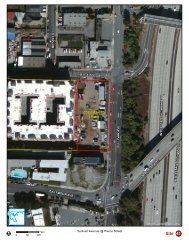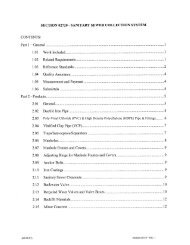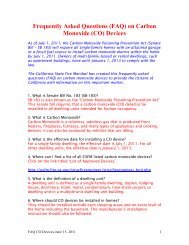Daly City's Green Vision - City of Daly City
Daly City's Green Vision - City of Daly City
Daly City's Green Vision - City of Daly City
You also want an ePaper? Increase the reach of your titles
YUMPU automatically turns print PDFs into web optimized ePapers that Google loves.
A.1.5.3 Information Items<br />
Information items are emissions sources that, for a variety <strong>of</strong> reasons, are not included as Scope 1, 2, or 3 emissions<br />
in the inventory. In order to provide a more complete picture <strong>of</strong> emissions from <strong>Daly</strong> <strong>City</strong>’s operations, however,<br />
these emissions should be quantified and reported.<br />
In this report, the following emissions are included as information items (emission quantities are reported in<br />
Appendix B):<br />
<br />
<br />
Scope 1 CO 2 emissions from flared methane from biogas emitted during wastewater treatment<br />
Ozone depleting chemical used as refrigerants (R-22)<br />
A common emission type that is categorized as an information item is carbon dioxide caused by the combustion <strong>of</strong><br />
biogenic fuels. Local governments will <strong>of</strong>ten burn fuels that are <strong>of</strong> biogenic origin (wood, landfill gas, organic solid<br />
waste, bi<strong>of</strong>uels, etc.) to generate power. Common sources <strong>of</strong> biogenic emissions are the combustion <strong>of</strong> landfill gas<br />
from landfills or biogas from wastewater treatment plants, as well as the incineration <strong>of</strong> organic municipal solid<br />
waste at incinerators.<br />
Carbon dioxide emissions from the combustion <strong>of</strong> biogenic fuels are not included in Scope 1 based on established<br />
international principles. 20 These principles indicate that biogenic fuels (e.g., wood, biodiesel), if left to decompose<br />
in the natural environment, would release CO 2 into the atmosphere, where it would then enter back into the natural<br />
carbon cycle. Therefore, when wood or another biogenic fuel is combusted, the resulting CO 2 emissions are akin to<br />
natural emissions and should therefore not be considered as human activity-generated emissions. The CH 4 and N 2 O<br />
emissions, however, would not have occurred naturally and are therefore included as Scope 1 emissions.<br />
A.2 Baseline Years<br />
Part <strong>of</strong> the local government operations emissions inventory process requires selecting a “performance datum” with<br />
which to compare current emissions, or a base year. Local governments should examine the range <strong>of</strong> data they have<br />
over time and select a year that has the most accurate and complete data for all key emission sources. It is also<br />
preferable to establish a base year several years in the past to be able to account for the emissions benefits <strong>of</strong> recent<br />
actions. A local government’s emissions inventory should comprise all greenhouse gas emissions occurring during a<br />
selected calendar year.<br />
20 Methane and nitrous oxide emissions from biogenic fuels are considered Scope 1 stationary combustion emissions and are included in the<br />
stationary combustion sections for the appropriate facilities.<br />
2005 <strong>Daly</strong> <strong>City</strong> Government Operations <strong>Green</strong>house Gas Emissions Inventory V


